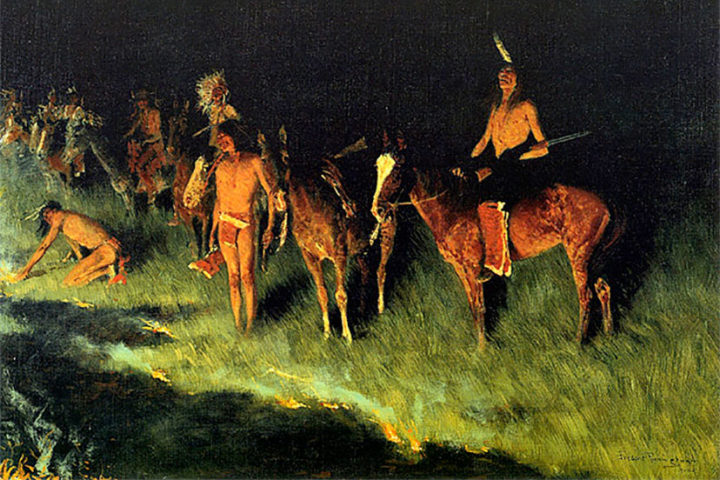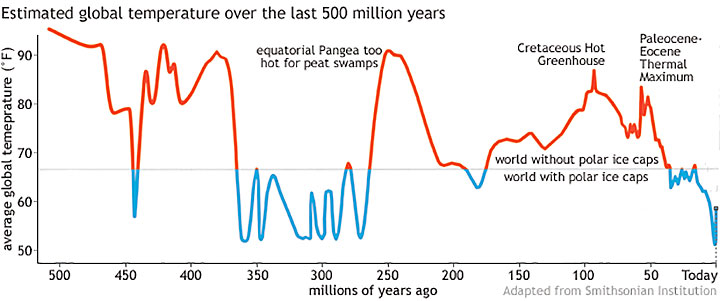In this editorial series, we’re considering “Severe Wildfire”, among other things. Also “organismal biology” and “ecology”.
We’re also considering how little we understand about the world, on a macroscopic level — visible to the naked eye — and on a microscopic level.
Earlier this week, in Part One, we considered some scientific evidence that the Earth, in prehistoric times, was typically much warmer than it is in 2021. I shared a chart based on a Smithsonian Institute analysis.
Graphs like these are built upon scientific theories, which are sometimes highly imaginative explanations based on relatively little actual data. But if we want to run with the theories, it would appear that humans are still living in an “icebox” phase of global temperatures, compared to other periods of Earth’s history. Apparently, life continued to thrive on the planet, even when average temperatures were 30ºF warmer than today.
Some scientists want to blame recent ‘mega-fires’ on warming temperatures — temperatures that may have increased by maybe one degree over the past 100 years. Some models show recent temperature increases as somewhat greater in the American West than in other parts of the U.S. So, maybe two degrees warmer?
Those two degrees of average increase are often cited in the media, as one explanation for severe wildfires in Colorado, California and the rest of the American West.
So, here’s a science question. If the average global temperature, in 2021, is 60ºF… and if a one- or two-degree temperature increase is now (theoretically) resulting in massive forest fires… what kind of wildfires were occurring in the world’s conifer forests, 50 million years ago, when the average global temperature was 85ºF?
That’s a rhetorical question, of course. We will never know the answer. But we might consider whether the severe wildfires last year were mainly the result of climate change, or if they were mainly a result of an official government policy of ‘fire suppression’.
Many scientists and forestry managers, nowadays, are leaning toward the latter explanation. We intentionally stopped our forests from burning, and now we’re paying the price. Worse yet, we allowed our cities and towns to expand out into those suppressed forests, with little concern for the fact that all forests are destined to burn, eventually.
Fact is, fire is a time-tested part of forest ecology. Human beings are another time-tested part of the ecology.


From an article by Rob Jordan, published by Stanford University Woods Institute for the Environment, August 2019.
In collaboration with tribes in Northern California, researchers examined traditional fire management practices and found that these approaches, if expanded, could strengthen cultures and reduce the risk of catastrophic wildfires…
Things we assume to be harmful sometimes turn out to be beneficial, when we open our eyes.
This editorial series was inspired by a couple of students at Colorado College — Riley Prillwitz, a media studies major, and Leah Thayer, majoring in organismal biology and ecology — who plan to engage in a journalism project, following a team of five scientists and a project titled “Role of Soil Microbiome Resilience in Ecosystem Recovery Following Severe Wildfire.”
The “Soil Microbiome Resilience” project has been funded by a $844,000 research grant from the National Science Foundation, and the two lead scientists are Colorado College professor Rebecca Barnes, a ‘biogeochemist’ focused on carbon processes within soils, and Mike Wilkins, a microbiologist and associate professor of soil and crop sciences at Colorado State University.
According to the online newsletter, “Burning Questions”:
Wilkins specializes in DNA and RNA sequencing, and is interested in how severe fires impact microbial communities (tiny villages of microorganisms, like bacteria and fungi)…
As mentioned in Part One, I’ve become interested in viruses lately. Perhaps Dr. Barnes and Dr. Wilkins are also interested in viruses… which also exist in the soil, actively infecting those tiny villages of bacteria and fungi.
“…viruses… which also exist in the soil…”
I almost wrote, “viruses… which also live in the soil.” But not everyone considers viruses to be ‘alive’. Scientists don’t agree on whether viruses should be defined as ‘living things’.
If you want to watch an fascinating 53-minute video about that question — “Are Viruses Alive?” — hosted by author Carl Zimmer, I have embedded it below. You might be amazed (as I was) by the number of things you didn’t know about viruses.
One thing about which there seems to be no debate: viruses are everywhere. Including, inside our bodies.
From Mr. Zimmer’s video:
“There are basically viruses everywhere inside of us. Some of them are infecting our host cells, even when we’re healthy, but the majority of them are infecting the trillions of bacteria that are inside of us.”
“So, in our bodies, in the soil, in the ocean, in Antarctic lakes [beneath 2 miles of ice]… how many viruses are there [on Earth]? Well, obviously, scientists haven’t counted them all, but they have been about to make an estimate, and here is the number. It’s a ‘one’ followed by 31 zeros.
“10,000,000,000,000,000,000,000,000,000,000
“It’s a number so big, it’s kind of hard to know what to make of it. So scientists have come up with creative ways of conceptualizing this.
“So, one way to think about this is: Okay, let’s take every virus and just stack them, one on top of another. How high would that stack be? How far would it go? Would it go from the Earth to the Moon? Well, yes. But then it would go beyond. You would actually leave our solar system. You would actually leave our galaxy.
“In fact — and this is from the scientific literature; I’m not making this up — if you stacked up 1031 viruses here on Earth — you would go 200,000,000 light years. That would take you past the 65 nearest galaxies.
“So that just might give you a sense of just how many viruses there are on this planet… all of which were produced by cells, and all of which have the potential to infect new hosts…”
Viruses. An integral part of our ecosystems. A dominant form of life?

